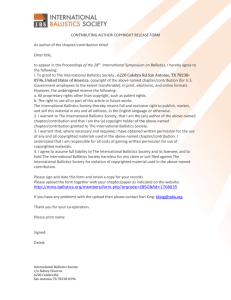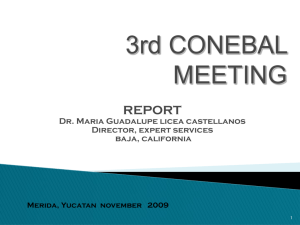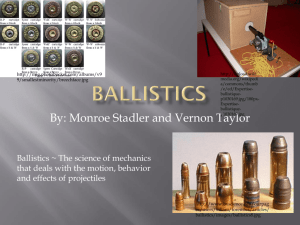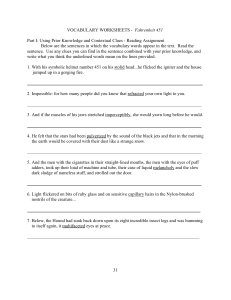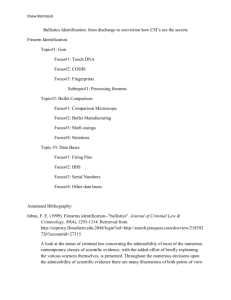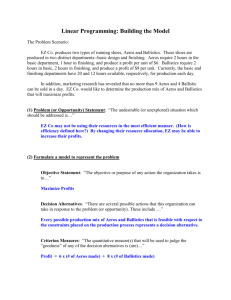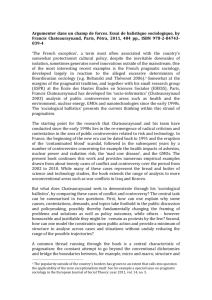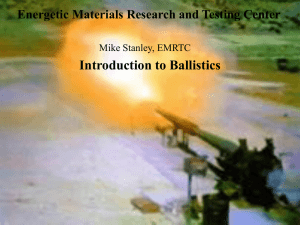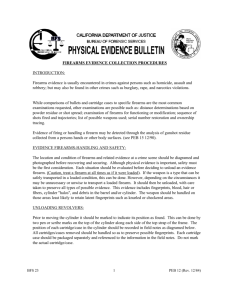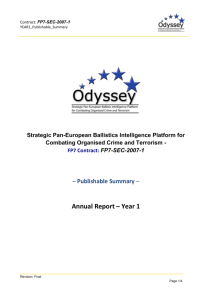Ballistics - The University of Oklahoma Department of Physics and
advertisement
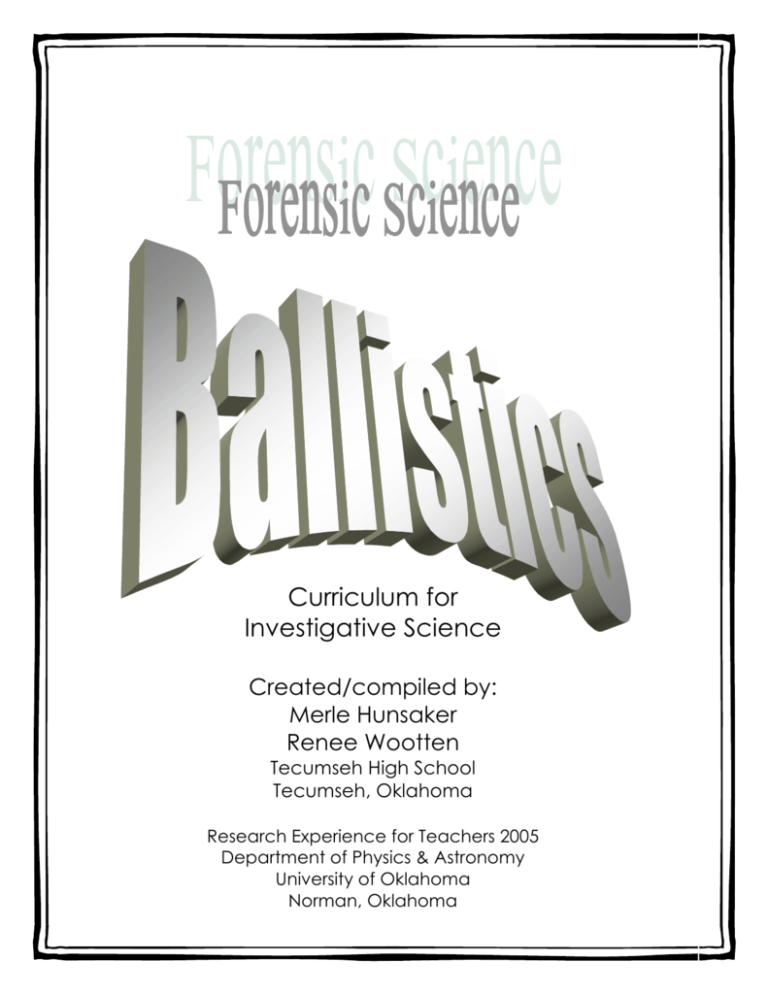
Curriculum for Investigative Science Created/compiled by: Merle Hunsaker Renee Wootten Tecumseh High School Tecumseh, Oklahoma Research Experience for Teachers 2005 Department of Physics & Astronomy University of Oklahoma Norman, Oklahoma Collaborations Special collaborators: Dr. David Von Minden, Forensics Chair, University of Central Oklahoma Frank Pasierb, Norman Police Department, Oklahoma Braden Parmer, student, Tecumseh High School, Oklahoma Aaron Hennen, student, Tecumseh High School, Oklahoma Greg Schader, student, Norman High School, Oklahoma University of Oklahoma collaborators: Caroline Hall, Project Manager Mark Curtis, Graduate Assistant Tuan Nguyen, Student Technician Kieran Mullen, Associate Professor of Physics Eric Abraham, Assistant Professor of Physics Matt Johnson, Associate Professor of Physics Lloyd Bumm, Assistant Professor of Physics RET Program University of Arkansas Department of Physics•Fayetteville, Arkansas _______ ____, 20____ Dear Parent/Guardian, Beginning _______________ our class will be working on a Forensic Science unit. This unit will last approximately _____ days. We will be studying firearm ballistics. We will investigate this area of forensics using a computer based virtual tutorial and no actual firearms will be used. If you have any questions, feel free to contact me at _______________ during my planning period __________ to __________. If you have any objection to your child participating in this forensic unit, please contact me and/or complete the information below. If such is the case, your child will complete an alternative study in the library. Sincerely, __________________________________________ I would prefer that my child ______________________________ not be involved in the forensics unit. I understand that an alternative unit will be presented in the library. ______________________________ _______________ Signature Date Forensic Science Unit Firearm Ballistics Lesson Plans I. Rationale Firearms evidence is common at many crime scenes. Crimes against persons, such as aggravated assault and homicides, are often sources of firearms evidence. Many of these types of evidence may offer additional clues to the identity of the shooter, because they may reveal a fingerprint or have blood, hair, or fibers adhering to them. Investigators should become familiar with different types of firearms. It is important for the crime scene technician to understand proper morphology when describing and analyzing weapons and ammunition. Since it would be nearly impossible and impractical to actually perform firearms ballistics tests, this lesson has been designed as a Virtual Lesson to study these techniques. This Virtual Lesson requires only one day in a computer lab setting, but could be expanded with extension and application activities. II. Objectives a. Cognitive Objectives Upon completion of the lesson, the student will be able to: Identify fundamental ballistics vocabulary. Recognize differences in ballistic and casing tool marks. Understand the importance of ballistics analysis in forensic science. b. Skills and Performance Objectives Upon completion of this lesson, the student will be able to: Utilize technology to understand the fundamental concepts of forensic ballistics. Use the virtual comparison microscope to match casings and projectiles. III. Materials IV. Computers and internet access Vocabulary puzzle Instructional handout Instructional Procedure A. Before lesson: Go to www.firearmid.com. In the right hand column under Login, click on Register. This will allow you to register yourself into the site. After registering, go to Classroom Registration. This will allow your students to access the site and you to monitor their activities. OU RET 2005 Ballistics Module teacher materials B. Opening Discussion Questions: 1) What is ballistics? 2) Why do investigators pick up casings at a crime scene? 3) If you find a projectile used in a crime, why is it important to find the gun? 4) What information do investigators gain from these objects? C. Middle Distribute the instructional handout with the information for the virtual tutorials. Distribute the vocabulary crossword puzzle for the students to complete during the virtual tutorials. Students will need to access the internet (www.firearmsid.com) Suggestion: instruct the students to check the bulleted boxes next to each step upon completion and take any necessary notes. D. Closing When the students have finished, check their certificates. Suggestion: allow them to go to the shooting galleries, giving others time to complete their work or challenge them to complete another VCM test. V. Activities OU RET 2005 Read tutorials over firearm fundamentals. Complete terminology puzzle. Apply knowledge about ballistics comparison with a simulated macroscope. Gain experience and increase skills using technology and the internet. Ballistics Module teacher materials Name ___________________________________________________________ Date ______________ Firearm Ballistics Virtual Laboratory Purpose/Objectives: the student will … Recognize differences in ballistic and casing tool marks. Use the virtual comparison microscope to match casings and projectiles. Understand the importance of ballistics analysis in forensic science. Instructions: Go to www.firearmsid.com Go to “classroom: Student Login” (right column) Instructor will provide log-in key Return to “Home” Under “Firearms ID”, select “Firearm identification” (left column) Under “Related Pages”, read: (Use “Related Pages” Menu to navigate) firearm id fundamentals Bullet Identification Caliber Rifling Rifling Impressions Cartridge Case ID Striated Action Marks Impressed Action Marks After reading, return to “Home” Under the “Resource Area”, select “Graphic Libraries” (right column) Locate “Photo Illustrations” Read and examine Firearms Bullets Bullet Comparisons Cartridge Case Comparisons Gunshot Residue Return to “Home” Under the “Resource Area”, select “BID-VCM” OR “CCID-VCM” (right column) Take Tests: 1, 2, 3, 4, or 5 (your choice) Upon completion, show instructor award With instructor permission, you may enter the “Virtual Shooting Galleries” OU RET 2005 Ballistics Module Handout Firearm Ballistics Teacher’s Suggestions: Since it would be nearly impossible to actually perform firearms/ballistics tests, you can use a Virtual Lesson to study these techniques. If the font on the website is too small, hold down the control button and use the scroll button on the mouse to scroll up or down. This will increase/decrease font size. Offer bonus points for successful completion of both the BID and CCID VCM exams. Instructions: Go to www.firearmsid.com. In the right hand column under Login, click on Register. This will allow you to register yourself into the site. After registering, go to Classroom Registration. This will allow your students to access the site and you to monitor their activities. Hand out the vocabulary crossword puzzle for the students to complete during the virtual tutorials. You might instruct the students to check the bulleted boxes next to each step and take whatever notes are necessary. When the students have finished, check their certificates. You may allow them to go to the shooting galleries, giving others time to complete their work. OU RET 2005 Ballistics Module teacher materials Firearm Ballistics OU RET 2005 Ballistics Module Handout Firearm Ballistics Across 1. size of the bullet 2. impressions made when bullet is released 3. where the bullet enters after firing and directs the projectile 4. allows aiming of the gun 5. marks left on the base of the cartridge after firing 6. created when the bullet enters the firing chamber 9. controls the action of the firing pin 10. this strikes the cartridge causing a small explosion to ignite the powder 11. the opposite force on a gun caused by firing 12. created by the expansion of the cartridge in the chamber 13. scratches made as the cartridge moves in firing chamber Down 1. used to match bullets and casings 7. groove pattern on the interior of a barrel 8. where the explosion occurs to propel the bullet OU RET 2005 Ballistics Module Handout
